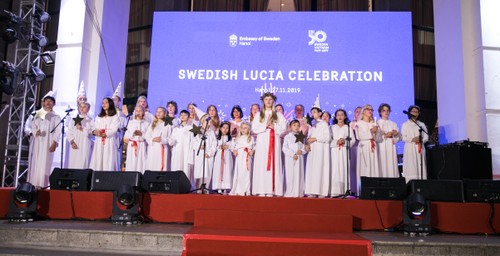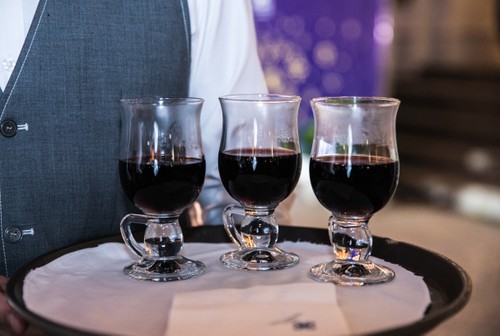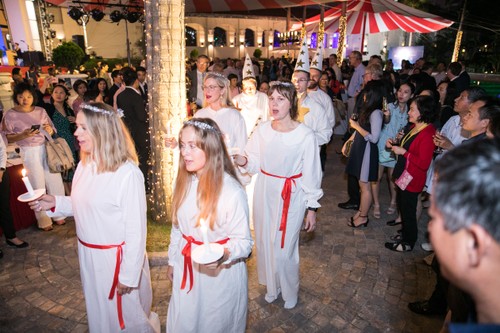 The Lucia choir in Hanoi. The Lucia choir in Hanoi. |
I was lucky to be invited to this year’s Lucia Celebration at the Swedish Embassy in Hanoi. The annual event took place in the Swedish style at Hanoi’s Daewoo Hotel, where 400 guests enjoyed the Lucia choir and a cup of glögg - Swedish mulled wine - and some traditional Swedish Christmas treats.
 Glögg - Swedish mulled wine. Glögg - Swedish mulled wine. |
Reporter: This is the first time I’ve attended a Lucia celebration. It showed one aspect of Swedish culture and brought a Swedish Christmas feeling to Hanoi. Could you describe the Lucia Celebration for those in our audience who haven’t heard of it?
Johan: In Sweden, we celebrate at the very darkest day of the year, we celebrate light. It is made up by a procession, the choir. The choir is the procession and they all dress out in white. In front of the procession, there is a Lucia. Every year we select one of the members of the choir to be the Lucia and she, sometimes so he, will get to carry lights in her candle lit. And we all dress out in white, plain white, robes and then we sing songs going back to ancient folklore and the Christian tradition.
Reporter: Is the celebration attached to any historical event?
Johan: There are two actually backgrounds or two places that it originates from. One is Swedish folklore. When it was at the darkest day of the year, there was a popular belief that there was a lot of supernatural beings in the making. They were roaming around outside. Then there is the Christian tradition of the Saint Lucia who is the Italian saint and she was the bearer of light to those without hope. So those two have been combined and since the beginning of the 1900s we have celebrated this version of Saint Lucia on the 13th of December.
Reporter: St. Lucia’s Day, the festival of lights, is celebrated in Sweden, Norway, and Swedish-speaking areas of Finland. Is the celebration the same in all these areas?
Johan: I would say it's rather similar. Of course sometimes if you travel abroad to the US, for instance, we have a quite big Swedish minority living there. And I think their tradition is perhaps more traditional than ours which is quite often the case when you have small …….living abroad these tend to preserve the tradition a bit better in a way than we back home in Sweden. But more or less it is the same.
 Johan Alvin, Swedish Embassy's second secretary (R), at the Lucia celebration 2019. Johan Alvin, Swedish Embassy's second secretary (R), at the Lucia celebration 2019. |
Reporter: I’m really impressed by the St. Lucia’s Day choir. Could you tell us more about it, for instance, its members and role, and the meaning of the songs performed?
Johan: Each school has its own choir. There are also professional choirs singing all year long and they would have formal Lucias as well. So most often it's from the schools. Sometimes even in workplaces you have choirs like in the Swedish Foreign Ministry. We have choirs in different departments and we go around the workplace on the 13th of December and sing to our colleagues as well.
Reporter: Are there any rules about choosing a person to act as Lucia?
Johan: That can be sometimes a bit delicate. Sometimes there is a bit of a competition as many people wants to be the Lucia. Traditionally it's always been a female Lucia. But in Sweden when we are testing all norms, we have also started having male Lucia, as in some places. That adds another version of delicacy because then you have even more people who could potentially be the Lucia. But here in Hanoi we have always said that it's the oldest female that has not yet been the Lucia this year.
Reporter: Is there any difference between Lucia choirs abroad, like the one that performed at this year’s celebration in Hanoi, and the traditional Lucia choirs in Sweden?
Johan: Here in Hanoi we have a rather small Swedish community. But if we add those that have a Swedish connection, it widens a little bit. What stands out here in Hanoi is that we invite children and also adults from the Swedish connected community in Hanoi to make out the choir. The youngest this year was just about four years old and the oldest probably 55. So large/wide age band here in Hanoi. So we have had roughly 20 to 25 people in the choir, mostly children that are living here in Hanoi and adults as well. Most of us have Swedish citizenship. But I would say that we have about six to seven that have mixed citizenships.
Reporter: Marika, I learnt that you instructed and performed in the Lucia choir this year. How long have you been a member of the choir?
Marika: We've lived here for two and a half years so this was my third Lucia choir or Lucia procession and I've joined it because I love singing and I think it's one of my absolute favorite holidays in Sweden. So that's why I want to get engaged and lead the choir this year.

Girls and boys clad in white full-length gowns, emerging from the darkness of a Swedish winter’s day and gently silencing the crowds with a procession of light.
|
Reporter: How many Lucia songs are there? What do these songs mean?
Marika: The common theme is light, bringing the light, and bringing back the warmth to Sweden, and bringing the light into the darkness. So that's the common theme. I have no idea how many Lucia songs there are. They vary a lot. We have probably old ones that are not sung anymore and we have new ones that come into the repertoire as well. The children know them all by heart. And the adults too. We've sung this ever since we were small kids and performed it even in kindergartens and day care so all of the kids know it by heart.
Reporter: Which song do you like best and why?
Marika: I like the main song the best “Saint Lucia” which is about Saint Lucia who comes with a light and that usually starts the procession and it also ends it. And it's very traditional and very beautiful.
Reporter: What else do people do during the Lucia celebration?
Marika: We eat a lot. Traditionally during this night as it is the longest night of the year, people stay up late. This is also the time that they prepare for winter so all the food is supposed to be prepared already. They stay awake all through the night to keep evil spirits away. That was very long time ago. To keep awake they eat a lot. This tradition then became a tool for their children to walk from house to house, they sang, they handed out food too. So the food is a very important par, especially cookies.
Reporter: Any taboo on Lucia Day?
Marika: Maybe stay quiet because we like to sing. So you shouldn't say to someone that they should keep quiet.
Johan: Apart from what my wife Marie has just said. …..and singing and then everything will be fine. I don't think there is anything in particular that you shouldn't mention to us. We're pretty easy. Yeah yeah… tradition has changed very much as well. Like this tradition this year, it has been around since the 12th century in one way or the other. And then it has changed very much over the years. The one you have two days since the beginning of the 1900s. So it's changing a lot. Of course, if you want, you can read in many different ways over the tradition into it. Of course, you can choose how you want to interpret it. But basically nowadays it's a good time to bring together friends and family before Christmas and then start getting into Christmas spirit.
Along with Midsummer, the Lucia Celebration is one of the principal cultural traditions in Sweden. Both recall life in the peasant communities of old with themes of darkness and light, cold and warmth.